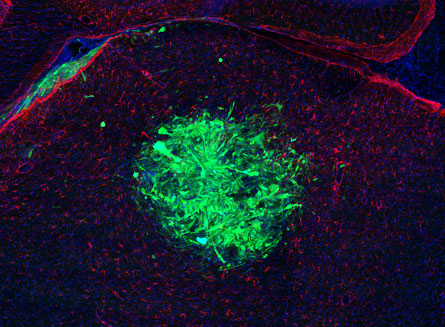- More than 2 years ago
New work could help explain why a deadly type of brain cancer recurs easily even after surgery, radiation and chemotherapy have apparently banished it. Fully developed brain cells, not just stem cells, may take on new identities to evade therapy and come back later, the study suggests.

Just two changes to cancer-related genes in some adult brain cells are enough to spur the genesis of glioblastomas, Inder Verma, a molecular biologist at the Salk Institute for Biological Studies in La Jolla, Calif., and colleagues report online October 18 in Science.
“To me it says something very scary,” says Martine Roussel, a molecular biologist at St. Jude Children’s Research Hospital in Memphis. “With just the right combination of hits you can become a glioma,” as glioblastomas are sometimes called.
Roussel, who studies a different type of brain cancer called medullablastoma, says that the new study delves into a debate about which types of cells can lead to cancer. Some forms of cancer seem to start only when mutations build up in specific cells. Previous studies had indicated that glioblastoma may result when genes within naturally occurring stem cells in the brain are mutated. But the new study indicates that glioblastoma can originate in at least two types of mature brain cells, and which genes are struck by mutations is more important than the type of cell, Roussel says.
In the study, Verma’s team infected a small number of brain cells in mice with viruses carrying genes that reproduce alterations found in patients with glioblastoma. Each infected brain cell suffered a one-two punch when the virus simultaneously shut down a protein called p53 — which normally stops cells from growing out of control — and activated one of two cancer-promoting proteins. The double hit caused two types of brain cells known as astrocytes and neurons to revert to a more flexible, stem cell–like state, the researchers found. Some cells may even be able to switch identities directly, with astrocytes becoming neurons. Other researchers have shown that tumor cells can transform into blood vessel cells, potentially enabling oxygen-starved cells in the middle of a tumor to switch identities and build their own blood supply, Verma says.
Researchers have been reprogramming adult cells in laboratory dishes for several years now, but the new findings indicate that some types of cancer may result when that sort of reprogramming happens in the body, says Jean-Paul Thiery, a developmental biologist at the National University of Singapore. That could be ominous for cancer patients and their doctors, because constantly morphing tumor cells may be nearly impossible to get rid of, especially if therapies are aimed at only one biological process within cancer cells. “If you’re chasing one target,” he says, “you’ll always miss the boat.”






